Linear DVS-2400 User Manual 3
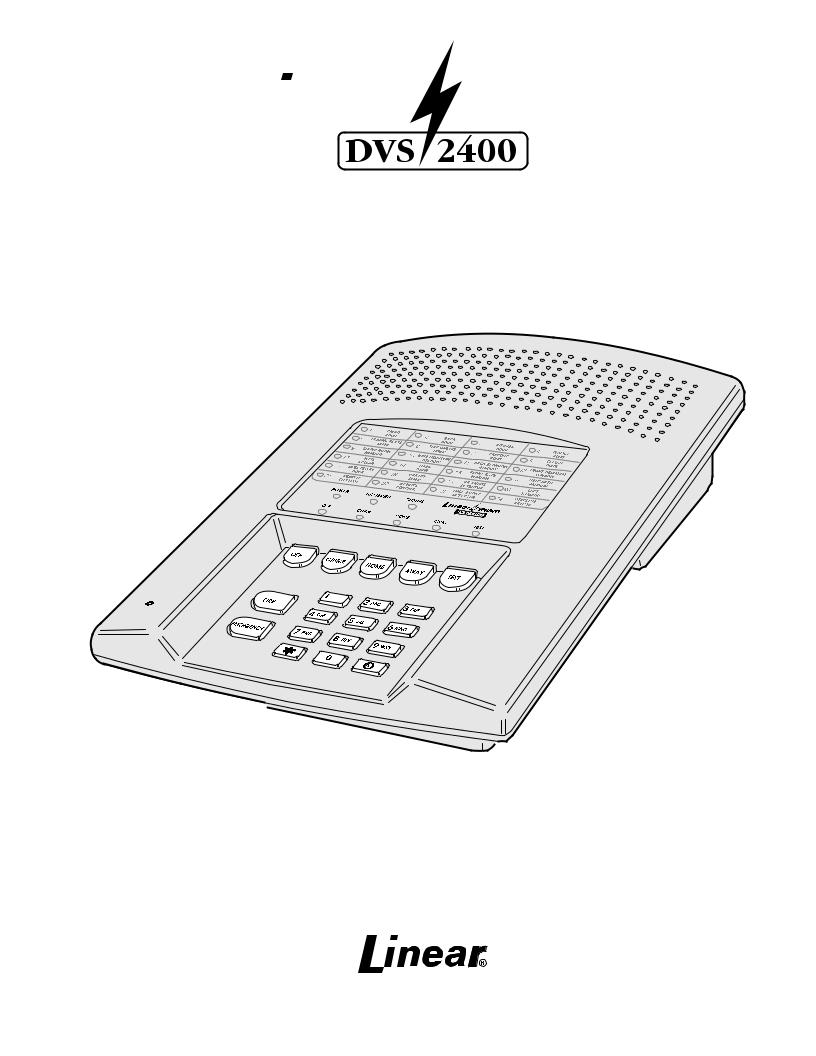




 SECURITY
SECURITY
SUPERVISED WIRELESS
SECURITY CONSOLE
Installation & Programming Instructions
(760) 438-7000 • FAX (760) 438-7043 www.linearcorp.com
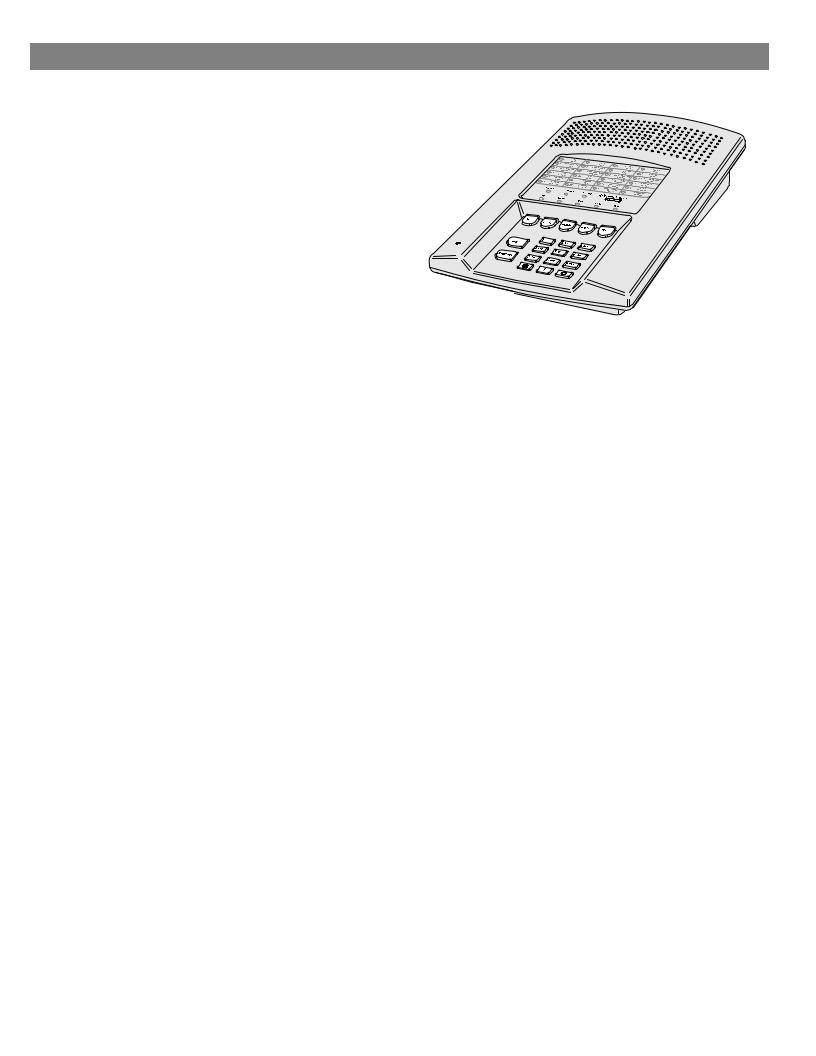
INTRODUCTION
CONGRATULATIONS for selecting Linear’s DVS-2400 Security System. The DVS-2400 Console incorporates many advanced and sophisticated features. The system can be expanded and customized to fit the installation’s specific needs.
The DVS-2400 Console and its accessories are designed and manufactured by the oldest wireless security company in North America. You can look ahead to many years of reliable service with this Console and its accessories.
Many insurance companies offer discounts on homeowners and renters policies when a security system is installed. Discount credits vary with different companies and generally increase in savings with an increase in the level of protection. Inform the user to ask their insurance agent about savings available.
NOTE: Some cities and municipalities may require an alarm system permit. Check with your local authorities before installing this system.
In this manual, the bullets preceding the text help to define the step. For example:
This symbol indicates a feature.

 This symbol indicates an action to perform and provides a box to check when the action is completed.
This symbol indicates an action to perform and provides a box to check when the action is completed.
This symbol is for lit indications or system sounds.
This symbol is for important notes.

|
TABLE OF CONTENTS |
|
1. THE DVS-2400 SECURITY SYSTEM . . . . . . . . . . . . . . . . . . . . . . . . . |
. 2 |
|
|
CONSOLE . . . . . . . . . . . . . . . . . . . . . . . . . . . . . . . . . . . . . . |
. 2 |
|
DOOR/WINDOW SENSORS . . . . . . . . . . . . . . . . . . . . . . . . . . . . |
. 3 |
|
WIRELESS KEYPAD . . . . . . . . . . . . . . . . . . . . . . . . . . . . . . . . . |
3 |
|
SMOKE DETECTORS . . . . . . . . . . . . . . . . . . . . . . . . . . . . . . . . . |
3 |
|
REMOTE CONTROLS . . . . . . . . . . . . . . . . . . . . . . . . . . . . . . . . . |
3 |
|
PANIC BUTTONS . . . . . . . . . . . . . . . . . . . . . . . . . . . . . . . . . . . |
3 |
|
BILL TRAP . . . . . . . . . . . . . . . . . . . . . . . . . . . . . . . . . . . . . . . |
3 |
|
PASSIVE INFRARED MOTION DETECTOR . . . . . . . . . . . . . . . . . . . . . |
3 |
|
GLASS BREAK DETECTOR . . . . . . . . . . . . . . . . . . . . . . . . . . . . . |
3 |
2. SECURITY SYSTEM FLOOR PLAN . . . . . . . . . . . . . . . . . . . . . . . . . . |
4 |
|
|
EXAMPLE SYSTEM . . . . . . . . . . . . . . . . . . . . . . . . . . . . . . . . . . |
4 |
|
DESIGN THE INSTALLATION . . . . . . . . . . . . . . . . . . . . . . . . . . . . . |
4 |
3. |
TYPICAL SYSTEM SENSORS . . . . . . . . . . . . . . . . . . . . . . . . . . . . . |
5 |
|
DOOR/WINDOW SENSOR . . . . . . . . . . . . . . . . . . . . . . . . . . . . . . |
5 |
|
WIRELESS KEYPAD . . . . . . . . . . . . . . . . . . . . . . . . . . . . . . . . . |
5 |
4. |
CONSOLE FEATURES . . . . . . . . . . . . . . . . . . . . . . . . . . . . . . . . . |
6 |
5. |
CONSOLE INSTALLATION . . . . . . . . . . . . . . . . . . . . . . . . . . . . . . . |
8 |
|
CONSOLE LOCATION . . . . . . . . . . . . . . . . . . . . . . . . . . . . . . . . |
8 |
|
CASE LOCKING SCREW . . . . . . . . . . . . . . . . . . . . . . . . . . . . . . . |
8 |
|
WALL MOUNTING . . . . . . . . . . . . . . . . . . . . . . . . . . . . . . . . . . . |
8 |
|
EXTERNAL CONSOLE SPEAKER CONNECTION (OPTIONAL) . . . . . . . . . . . |
9 |
|
EXTERNAL ALARM SIREN CONNECTION (OPTIONAL) . . . . . . . . . . . . . . |
9 |
|
TELEPHONE LINE CONNECTION (OPTIONAL) . . . . . . . . . . . . . . . . . . |
10 |
|
AUTOMATION OUTPUT CONNECTION (OPTIONAL) . . . . . . . . . . . . . . . |
10 |
|
CONSOLE POWER CONNECTION . . . . . . . . . . . . . . . . . . . . . . . . . |
11 |
|
BACKUP BATTERY INSTALLATION (OPTIONAL) . . . . . . . . . . . . . . . . . |
11 |
6. |
BASIC CONSOLE PROGRAMMING . . . . . . . . . . . . . . . . . . . . . . . . . |
12 |
|
CREATE THE MASTER USER CODE . . . . . . . . . . . . . . . . . . . . . . . |
12 |
|
PROGRAM THE SENSORS INTO THE CONSOLE’S MEMORY . . . . . . . . . . |
12 |
|
PROGRAMMING DIFFERENT SENSOR TYPES . . . . . . . . . . . . . . . . . . |
13 |
7. |
BASIC SENSOR INSTALLATION . . . . . . . . . . . . . . . . . . . . . . . . . . |
14 |
|
DXS-10 WIRELESS KEYPAD . . . . . . . . . . . . . . . . . . . . . . . . . . . . |
14 |
|
DXS-31 DOOR/WINDOW SENSORS . . . . . . . . . . . . . . . . . . . . . . . . |
15 |
|
TEST SENSORS . . . . . . . . . . . . . . . . . . . . . . . . . . . . . . . . . . . |
15 |
8. |
CUSTOMIZING THE CONSOLE . . . . . . . . . . . . . . . . . . . . . . . . . . . |
16 |
|
LABELING THE SENSORS . . . . . . . . . . . . . . . . . . . . . . . . . . . . . |
16 |
9. |
CONSOLE OPERATING MODES . . . . . . . . . . . . . . . . . . . . . . . . . . . |
17 |
|
OFF MODE . . . . . . . . . . . . . . . . . . . . . . . . . . . . . . . . . . . . . |
17 |
|
CHIME MODE . . . . . . . . . . . . . . . . . . . . . . . . . . . . . . . . . . . . |
17 |
|
HOME MODE . . . . . . . . . . . . . . . . . . . . . . . . . . . . . . . . . . . . |
18 |
|
SECURE EXIT . . . . . . . . . . . . . . . . . . . . . . . . . . . . . . . . . . . . |
18 |
|
HOME INSTANT MODE . . . . . . . . . . . . . . . . . . . . . . . . . . . . . . . |
18 |
|
MANUAL BYPASSING OF SENSORS . . . . . . . . . . . . . . . . . . . . . . . |
18 |
|
AWAY MODE . . . . . . . . . . . . . . . . . . . . . . . . . . . . . . . . . . . . |
19 |
|
MANUAL BYPASSING OF SENSORS . . . . . . . . . . . . . . . . . . . . . . . |
19 |
|
TEST MODE . . . . . . . . . . . . . . . . . . . . . . . . . . . . . . . . . . . . . |
20 |
10. SYSTEM TROUBLE INDICATIONS . . . . . . . . . . . . . . . . . . . . . . . . . . 21 CONSOLE LOW BATTERY . . . . . . . . . . . . . . . . . . . . . . . . . . . . . 21 SENSOR LOW BATTERIES . . . . . . . . . . . . . . . . . . . . . . . . . . . . . 21 SENSOR RADIO TROUBLE . . . . . . . . . . . . . . . . . . . . . . . . . . . . . 21
11. CUSTOMIZING THE SYSTEM . . . . . . . . . . . . . . . . . . . . . . . . . . . . |
22 |
ADDING SENSORS TO THE SYSTEM . . . . . . . . . . . . . . . . . . . . . . . |
22 |
REMOVING SENSORS FROM THE SYSTEM . . . . . . . . . . . . . . . . . . . |
22 |
MAKING A SENSOR A 24-HOUR DOOR CHIME . . . . . . . . . . . . . . . . . . |
23 |
MAKING A SENSOR INTERIOR . . . . . . . . . . . . . . . . . . . . . . . . . . |
23 |
MAKING A SENSOR PERFORM A DIFFERENT FUNCTION . . . . . . . . . . . |
24 |
12. ADVANCED PROGRAMMING . . . . . . . . . . . . . . . . . . . . . . . . . . . . . |
25 |
SETUP MODE . . . . . . . . . . . . . . . . . . . . . . . . . . . . . . . . . . . . |
25 |
CHANGING A SENSORS SUPERVISION . . . . . . . . . . . . . . . . . . |
26 |
CHANGING A SENSORS RESTORE REQUIREMENTS . . . . . . . . . . . |
26 |
ENTRY DELAY TIME . . . . . . . . . . . . . . . . . . . . . . . . . . . . . |
26 |
EXIT DELAY TIME . . . . . . . . . . . . . . . . . . . . . . . . . . . . . . . |
26 |
BURGLARY SIREN TIME . . . . . . . . . . . . . . . . . . . . . . . . . . . |
26 |
EMERGENCY SIREN TIME . . . . . . . . . . . . . . . . . . . . . . . . . . |
26 |
FIRE SIREN TIME . . . . . . . . . . . . . . . . . . . . . . . . . . . . . . . |
27 |
AUTOMATION OUTPUT TIME . . . . . . . . . . . . . . . . . . . . . . . . |
27 |
REMOTE CONTROL ARMING LEVEL . . . . . . . . . . . . . . . . . . . . |
27 |
REMOTE CONTROL DISARMING LEVEL . . . . . . . . . . . . . . . . . . |
27 |
ENTRY DELAY BEEPS . . . . . . . . . . . . . . . . . . . . . . . . . . . . |
27 |
EXIT DELAY BEEPS . . . . . . . . . . . . . . . . . . . . . . . . . . . . . . |
27 |
SILENT BURGLARY ALARMS . . . . . . . . . . . . . . . . . . . . . . . . |
28 |
SILENT EMERGENCY ALARMS . . . . . . . . . . . . . . . . . . . . . . . |
28 |
DISABLING QUICK ARMING . . . . . . . . . . . . . . . . . . . . . . . . . |
28 |
AUTOMATIC RESTORAL OF BYPASSED SENSORS . . . . . . . . . . . . |
28 |
AUTOMATIC BYPASSING OF OPEN SENSORS . . . . . . . . . . . . . . . |
28 |
AUTOMATION OUTPUT MODE DURING ALARM . . . . . . . . . . . . . . |
29 |
AUTOMATION ACTIVATION TONE . . . . . . . . . . . . . . . . . . . . . . |
29 |
REMOTE CONTROL ARM/DISARM CHIRP . . . . . . . . . . . . . . . . . |
29 |
AUTOMATION OUTPUT FLASHES DURING AND AFTER ALARM . . . . . |
29 |
AUTOMATION OUTPUT ON DURING ALARM . . . . . . . . . . . . . . . . |
29 |
AUTOMATION OUTPUT WHILE ARMED . . . . . . . . . . . . . . . . . . . |
30 |
AUTOMATION OUTPUT DURING EXIT/ENTRY DELAYS . . . . . . . . . . |
30 |
AUTOMATION OUTPUT POLARITY . . . . . . . . . . . . . . . . . . . . . |
30 |
REMOTE ACCESS PASSWORD . . . . . . . . . . . . . . . . . . . . . . . |
30 |
DURESS CODE . . . . . . . . . . . . . . . . . . . . . . . . . . . . . . . . |
30 |
MASTER USER CODE . . . . . . . . . . . . . . . . . . . . . . . . . . . . |
30 |
ADDITIONAL USER CODES . . . . . . . . . . . . . . . . . . . . . . . . . |
31 |
REMOVING USER CODES . . . . . . . . . . . . . . . . . . . . . . . . . . |
31 |
CONSOLE MASTER RESET . . . . . . . . . . . . . . . . . . . . . . . . . |
31 |
13. COMMUNICATOR PROGRAMMING . . . . . . . . . . . . . . . . . . . . . . . . . |
32 |
SETUP MODE . . . . . . . . . . . . . . . . . . . . . . . . . . . . . . . . . . . . |
32 |
GENERAL COMMUNICATOR OPTIONS . . . . . . . . . . . . . . . . . . . . . . |
33 |
COMMUNICATOR ENABLE . . . . . . . . . . . . . . . . . . . . . . . . . . |
33 |
2-WAY AUDIO . . . . . . . . . . . . . . . . . . . . . . . . . . . . . . . . . |
33 |
VOICE RESPONSE . . . . . . . . . . . . . . . . . . . . . . . . . . . . . . |
33 |
REMOTE LOCKOUT . . . . . . . . . . . . . . . . . . . . . . . . . . . . . . |
33 |
CALL LIMITER . . . . . . . . . . . . . . . . . . . . . . . . . . . . . . . . . |
34 |
DIALING DELAY . . . . . . . . . . . . . . . . . . . . . . . . . . . . . . . . |
34 |
DIALING METHOD . . . . . . . . . . . . . . . . . . . . . . . . . . . . . . |
34 |
COMMUNICATOR REPORTING OPTIONS . . . . . . . . . . . . . . . . . . . . . |
35 |
REPORTING FORMAT . . . . . . . . . . . . . . . . . . . . . . . . . . . . |
35 |
CALL ROUTING . . . . . . . . . . . . . . . . . . . . . . . . . . . . . . . . |
35 |
ACCOUNT NUMBER . . . . . . . . . . . . . . . . . . . . . . . . . . . . . |
36 |
PRIMARY TELEPHONE NUMBER . . . . . . . . . . . . . . . . . . . . . . |
36 |
SECONDARY TELEPHONE NUMBER . . . . . . . . . . . . . . . . . . . . |
36 |
SUPERVISORY/PAGER TELEPHONE NUMBER . . . . . . . . . . . . . . |
36 |
REPORT CONSOLE TROUBLE . . . . . . . . . . . . . . . . . . . . . . . . |
37 |
REPORT FORCE ARMING . . . . . . . . . . . . . . . . . . . . . . . . . . |
37 |
OPENING AND CLOSING REPORTS . . . . . . . . . . . . . . . . . . . . . |
37 |
POINT ID REPORTING . . . . . . . . . . . . . . . . . . . . . . . . . . . . |
37 |
COMMUNICATOR REPORTING CODES . . . . . . . . . . . . . . . . . . . . . . |
38 |
GENERAL REPORTING CODES . . . . . . . . . . . . . . . . . . . . . . . |
38 |
SYSTEM REPORTING CODES . . . . . . . . . . . . . . . . . . . . . . . . |
38 |
FORCE ARMING REPORTING CODE . . . . . . . . . . . . . . . . . . . . |
39 |
DURESS REPORTING CODE . . . . . . . . . . . . . . . . . . . . . . . . . |
39 |
4 BY 2 FORMAT POINT ID REPORTING CODES . . . . . . . . . . . . . . . . . |
40 |
4 BY 2 FORMAT POINT ID ALARM REPORT CODES . . . . . . . . . . . . |
40 |
4 BY 2 FORMAT POINT ID TROUBLE REPORT CODES . . . . . . . . . . |
40 |
IMPORTANT INFORMATION . . . . . . . . . . . . . . . . . . . . . . . . . . . . . . . . 42 LINEAR LIMITED WARRANTY . . . . . . . . . . . . . . . . . . . . . . . . . . . . 42 WIRELESS PRODUCT NOTICE . . . . . . . . . . . . . . . . . . . . . . . . . . . 42 FCC NOTICE . . . . . . . . . . . . . . . . . . . . . . . . . . . . . . . . . . . . . 42 FCC TELEPHONE RULES AND REGULATIONS . . . . . . . . . . . . . . . . . . 42 FIRE EVACUATION PLANNING . . . . . . . . . . . . . . . . . . . . . . . . . . . 42 INDUSTRY CANADA NOTICES . . . . . . . . . . . . . . . . . . . . . . . . . . . 42
1
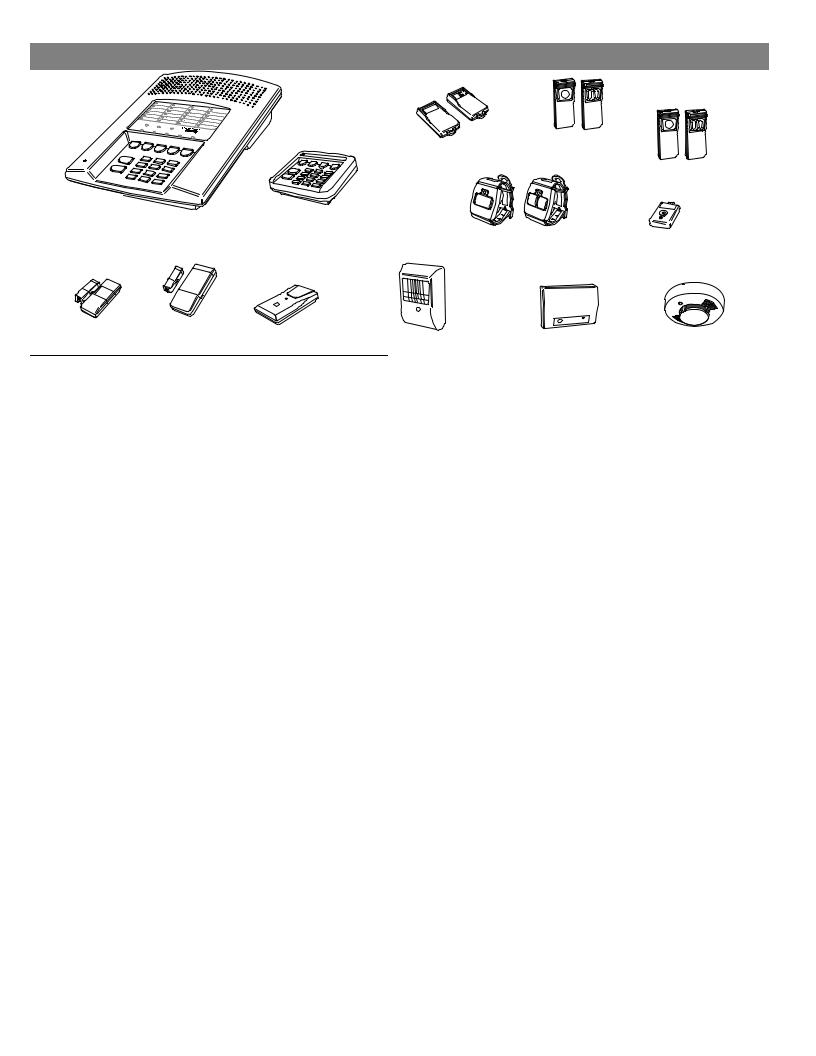
1. THE DVS-2400 SECURITY SYSTEM
DVS-2400
CONSOLE DXS-10
WIRELESS
KEYPAD
DXS-32 |
DXS-31 |
DXS-81 |
DOOR/WINDOW |
DOOR/WINDOW |
|
SENSOR |
SENSOR |
BILL TRAP |
CONSOLE
The DVS-2400 Console is the heart of the system. It monitors all of the system’s wireless sensors and controls the alarm sirens.
The Console constantly monitors the condition of the system’s sensors, displaying which protected doors and windows are open or closed. If an alarm occurs, the Console displays which sensor(s) caused it. When a sensor has a low battery, the Console displays which sensor needs a new battery. Sensors that send hourly status transmissions keep the Console informed of their operating condition.
Up to eight different custom user codes can be used to operate the system. For security, a user code must be entered to disarm (turn off) the system. The system can be armed (turned on) by entering a user code, or with the unique “Quick Arm” feature. The five restricted user codes and the special page alert user code can only arm and disarm the system, no programming changes are allowed. The master user code is allowed to program the Console, and a duress code can be selected for emergency disarming of the system with a duress report to the Central Station. The page alert user code can dial a pager number to inform the pager wearer when the Console is disarmed.
The Console’s memory will retain the user codes and all of the system’s programming, even during a total power loss. An optional backup battery can be installed to power the system during short power failures.
The built-in digital communicator connects the Console to a Central Alarm Monitoring Station through the telephone. With a monitored system, the central station can dispatch authorities in case of burglary, fire or other emergency. The central station can also call family, friends, neighbors, or anyone else designated on a custom call list.
Each sensor can report directly to the Central Station using the digital communicator’s Point ID feature. If a sensor triggers an alarm or experiences supervisory trouble, a unique report code can be sent for immediate identification of the event.
The optional Models VB-2 or VB-3 digital voice synthesis modules can be installed in the Console. The VB-2 module provides three exciting features: 2-way audio monitoring
DXT-21 & DXT-23
DXT-41 & DXT-42 REMOTES
REMOTES
DXS-21 & DXS-23
REMOTES
DXS-62 & DXS-63 |
DXT-61 |
REMOTES |
REMOTE |
DXS-54 |
DXS-91 GLASS |
DXS-72 |
PIR |
BREAK DETECTOR |
SMOKE DETECTOR |
capability at the Central Station through the communicator, local human voice prompts from the Console’s speaker, and voice prompted remote system control using in-house or off-site pushbutton telephones. The economy Model VB-3 is the same as the VB-2 without 2-way Central Station audio capability.
The Console has 24-hour capabilities that are always ready to operate, even when the Console is disarmed. They can be triggered by buttons on the Console, the Wireless Keypad, portable remote controls and smoke detectors. Pressing the [EMERGENCY] or [FIRE] button for two seconds will cause an immediate siren and call the central station. IMPORTANT: For personal emergency use only.
The Console’s Environmental feature is active 24-hours and can be triggered with sensors connected to devices such as water flow detectors, over/under temperature sensors, flood sensors, toxic gas detectors, etc. The Environmental feature activates the chime annunciator without sounding the siren. The Environmental feature does not send communicator reports.
An Automation Output in the Console provides an easy way to connect external devices to the Console. The output is fully programmable to activate on a variety of conditions, such as when the system is armed, during alarms, and during exit/entry delays. The Automation Output can connect to lighting control modules, relays, noisemakers, and indicators. The Console’s and wireless keypad’s (A) key and transmitters can control the Automation Output.
The Console can be programmed locally using its own keypad or remotely, over the telephone, using Linear’s Model RA-2400
Remote Access software program. The RA-2400 upload/download program is aWindowsapplicationthat runs
on a personal computer and communicates with the Console through a modem, connected directly to the Console or through the telephone line.
2
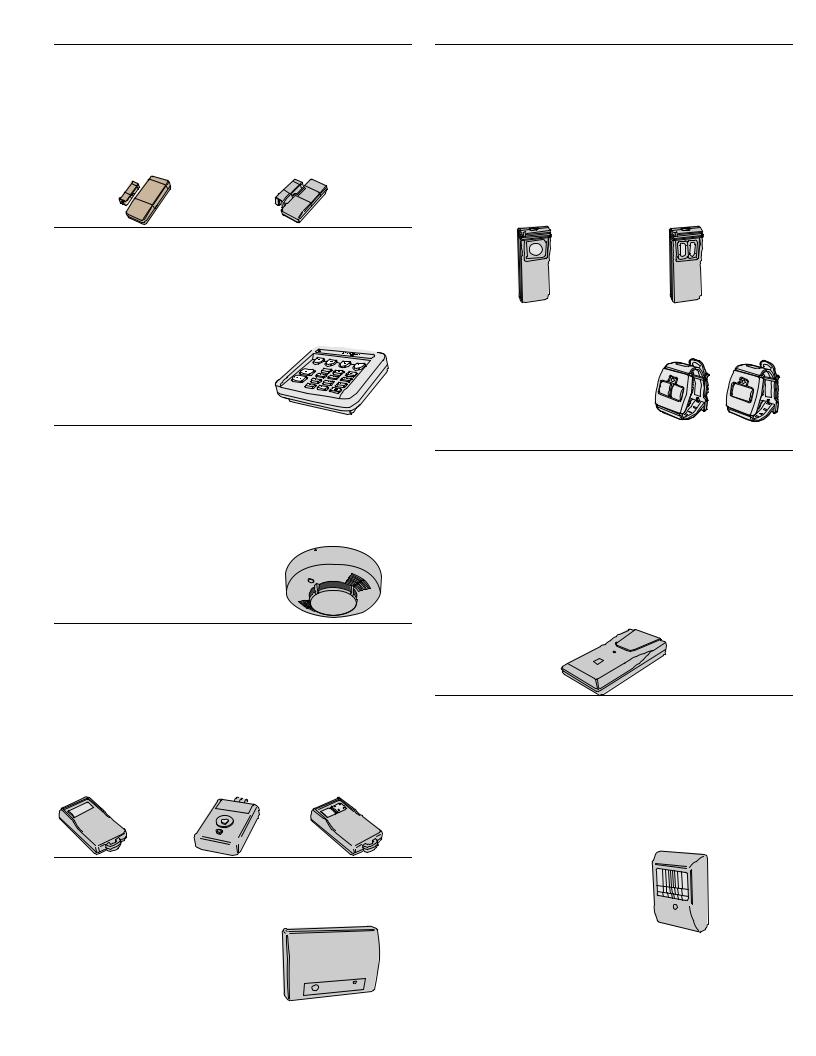
DOOR/WINDOW SENSORS
TheDXS-31&DXS-32sensorsmonitordoorsandwindows.They send radio signals to the Console. One type of signal is sent when the door or window is opened, and a different type of signal is sent when the door or window is closed. If the Console is armed, a sensor can trigger the Console’s burglary siren when its door or window is opened. Both sensors are supervised, and send hourly status reports and monitor battery condition.
DXS-31 |
DXS-32 |
|
WIRELESS KEYPAD
The DXS-10 wireless keypad is used to control the Console remotely. It can be placed in a convenient spot so the user doesn’t have to go to the Console to control the system. The wireless keypad can also trigger the emergency or fire siren and actuate the Automation Output. Pressing the [ ] key will cause the Console to sound beeps corresponding to the current operating mode. The DXS-10 is 
supervised, it sends hourly status reports and monitors its battery condition.
DXS-10
SMOKE DETECTORS
The DXS-72 is a high quality smoke detector with a built-in radio transmitter. As soon as smoke is detected, the unit will sound its local noisemaker. Then, 20 seconds after the local noisemaker sounds, the transmitter sends an alarm signal to the Console. The alarm signal will be repeated every 20 seconds as long as smoke is still present. A restoral signal will be sent when the smoke detection chamber clears. The DXS-72 is
supervised, and sends hourly status reports and monitors battery condition.
REMOTE CONTROLS
The DXT-41, DXT-61 single-button and DXT-23, DXT-42 multi-button remote controls can be used to remotely arm and disarm the Console. The DXT-42’s left button will arm and the right button will disarm the Console. Pressing both buttons simultaneously on the DXT-42 will trigger the emergency siren. Alternately, the console can be programmed to respond to the DXT-42 by arming and disarming with the left button, and activating the automation output with the right button. Each transmitter can be programmed to activate various other Console functions. These transmitters are not supervised.
DXT-41
DXT-42
DXT-61
GLASS BREAK DETECTOR
The DXS-91 is a glass break detector with an audio sound discriminator and a built-in radio transmitter. The unit “listens” for the sound of breaking glass.
When glass breakage is detected, the unit sends an alarm signal to the Console. The DXS-91 is supervised, it sends hourly status reports and monitors its battery condition.
PANIC BUTTONS
The DXT-21, DXS-21 single-button and DXT-23 and DXS-23 two-button transmitters can be used as portable “panic buttons”. Pressing the front or top button on the DXT-21, DXS-21 at any time will trigger the emergency siren. Pressing both front buttons simultaneously on the DXT-23 & DXS-23 at any time will trigger the emergency siren. These transmitters can be programmed to activate various other Console functions. The DXT-21 and DXT-23 transmitters are not supervised. The DXS-21 and DXS-23 transmitters are supervised.
DXT-21 |
DXT-23 |
DXS-21 |
DXS-23 |
The DXS-62 and DXS-63 transmitters can be used as portable “panic buttons”. Pressing the single button on the DXS-62, or pressing both buttons on the
DXS-63, at any time will trigger the emergency siren. These supervised transmitters send hourly status signals and low battery signals if the battery is low.
BILL TRAP
The DXS-81 bill trap can be used with the Console in small commercial hold-up installations. The unit is concealed in a cash drawer under a stack of currency, with a single “bait” bill secured in its money clip. During a hold-up, the cashier removes the stack of currency along with the “bait” bill. When a “bait” bill is removed, the transmitter sends a signal to the Console. Four additional signals are sent within the first minute after the “bait” bill is removed. When the “bait” bill is replaced, a restore signal is sent. The DXS-81 is supervised, it can send hourly status reports (optional) and monitors its battery condition.
DXS-81
PASSIVE INFRARED MOTION DETECTOR
The DXS-54 is a passive infrared (PIR) motion detector with a built-in radio transmitter. The PIR detects motion in its detection pattern by measuring the infrared emission levels of objects that it “sees”. If the infrared levels change quickly, as when a person moves across the detection pattern, the PIR will recognize the change as an intrusion and send an alarm signal to the Console. An alarm will be triggered if the Console is in the Away Mode. The DXS-54 is supervised, it
sends hourly status reports and monitors its battery condition.
DXS-54
3
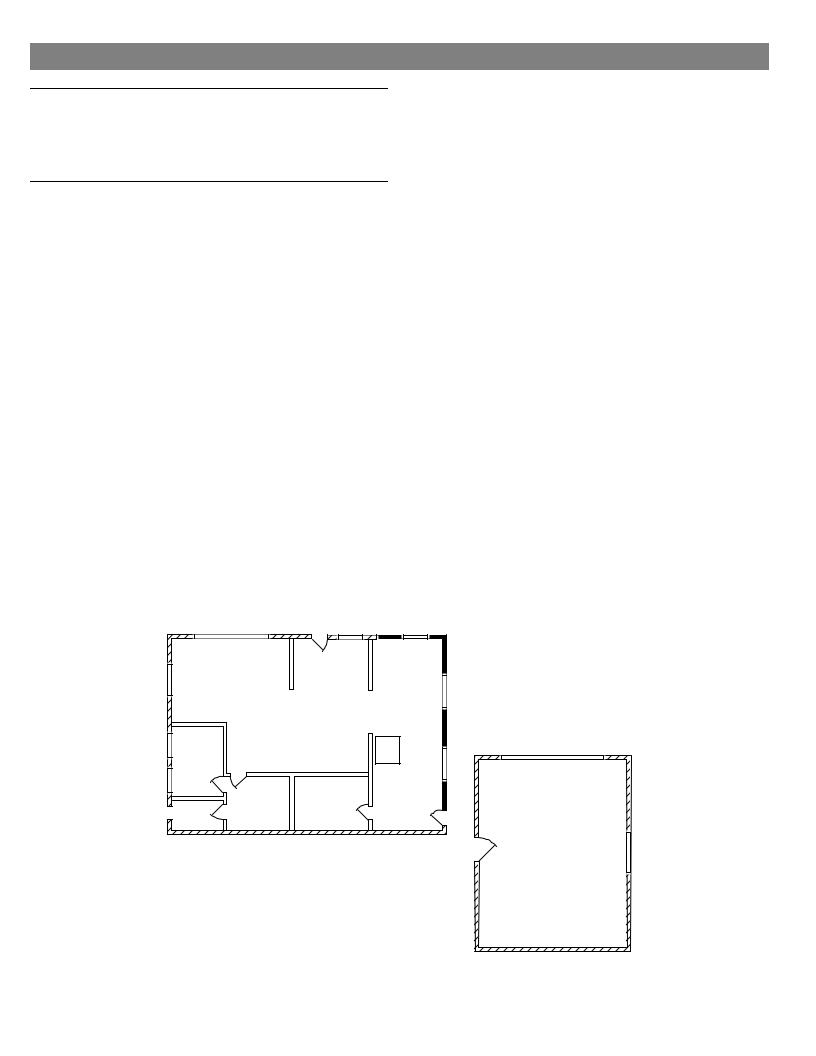
2. SECURITY SYSTEM FLOOR PLAN
EXAMPLE SYSTEM
The example shows a typical DVS-2400 system.
Any or all of the accessories shown can be used.
A total of 24 sensors (including keypads) can be used with each Console.
DESIGN THE INSTALLATION

 Create a floor plan of the installation.
Create a floor plan of the installation.

 Consider the security needs of the premises.
Consider the security needs of the premises.

 Determine which doors and windows are vulnerable to intrusion.
Determine which doors and windows are vulnerable to intrusion.

 Figure which interior areas an intruder might go to if unlawful entrance is gained.
Figure which interior areas an intruder might go to if unlawful entrance is gained.

 Indicate locations for door/window sensors, interior motion detectors, keypads, glass break detectors and external siren speakers.
Indicate locations for door/window sensors, interior motion detectors, keypads, glass break detectors and external siren speakers.

 Decide on a centralized location for the security Console.
Decide on a centralized location for the security Console.
ES |
|
|
|
|
|
MD |
|
GB |
S |
S |
MS |
|
|
|
WK |
|
|
|
|
LIVING |
ENTRY |
|
|
|
|
|
|
|
|
S |
|
|
|
|
S |
|
|
|
|
|
KITCHEN |
S |
BED |
|
DINING |
|
CON |
|
|
|
|||
|
|
|
|
|
MS |
MS |
SD |
|
|
|
|
|
|
BED |
|
S |
|
S BATH |
|
|
|||
DEN |
|
|
|
||
NOTE: IN NEW CONSTRUCTION, NFPA 71 REQUIRES A SMOKE DETECTOR LOCATED INSIDE EACH BEDROOM AS WELL AS A SMOKE DETECTOR ON EACH LEVEL.
CON - CONSOLE
S - DOOR/WINDOW SENSOR WK - WIRELESS KEYPAD MD - MOTION DETECTOR ES - EXTERNAL SIREN
SD - SMOKE DETECTOR
GB - GLASS BREAK SENSOR
MS - EXTERNAL MAGNETIC SWITCH
S
S
GB
GARAGE
MD
Example Residential Security System Floor Plan
4
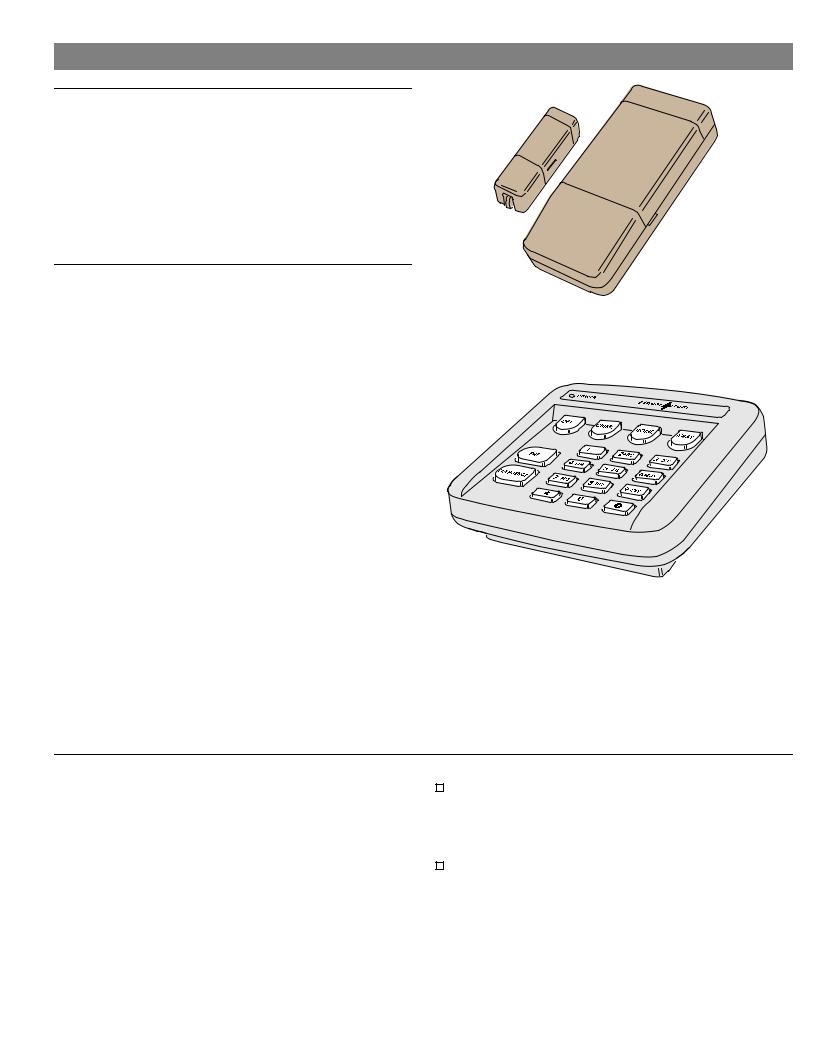
3. TYPICAL SYSTEM SENSORS
DOOR/WINDOW SENSOR
Sensor mounts on door or window with adjacent magnet.
Opening door or window moves magnet away, triggering sensor.
Internal lithium batteries are monitored by the
Console.
Sends hourly status reports to the Console.
Up to 3 years battery life (depends on frequency of activation).
WIRELESS KEYPAD
For controlling the system without having to go to the Console.
Emergency and fire alarm can be triggered from wireless keypad at any time.
Green operation light.
Internal 9-volt battery is monitored by the
Console.
Keypad’s beeper will buzz during transmissions when the battery is low.
Up to 3 years battery life (depends on frequency of activation).
Sends hourly status reports to the Console.Press the [(A)] key to activate the automation
output.
Pressing [ ] clears the keypad.
Holding [ ] for two seconds sounds the mode beeps from the Console.
Off Mode: 1 “Gong”
Chime Mode: 1 “Gong” & 1 “Beep”.
Home Mode: 1 “Gong” & 2 “Beeps”.
Away Mode: 1 “Gong” & 3 “Beeps”.
Test Mode: 1 “Bing” & 4 “Beeps”.
ABOUT SENSOR STATUS SUPERVISION
All DXS Format sensors transmit hourly status reports. All DXT Format sensors do not transmit hourly status reports. Both sensor formats can be used with the Console.
When a sensor is programmed into the Console, the Console will set the sensor as non-supervised or supervised. Sensors set as non-supervised are not expected to send hourly status reports. Sensors set as supervised are expected to send hourly status reports. If a status report is not received in 8 hours from a sensor set as supervised, the TROUBLE indicator will flash.
When sensors are programmed into the Console, ALL
STATIONARY SENSORS ARE SET AS SUPERVISED, ALL PORTABLE SENSORS ARE SET AS NON-SUPERVISED.
If stationary DXT Format sensors have been programmed into the Console, be sure to change their setting to non-supervised to prevent TROUBLE indications. This will not prevent low battery monitoring.
If portable DXS Format sensors have been programmed into the Console, and the installation requires supervision for specific portable sensor(s), change the selected portable sensors setting to supervised.
After programming the sensors, if changes are required, refer to “Changing a Sensors Supervision” on Page 26 for details on changing the way a sensor’s supervision is set.
5
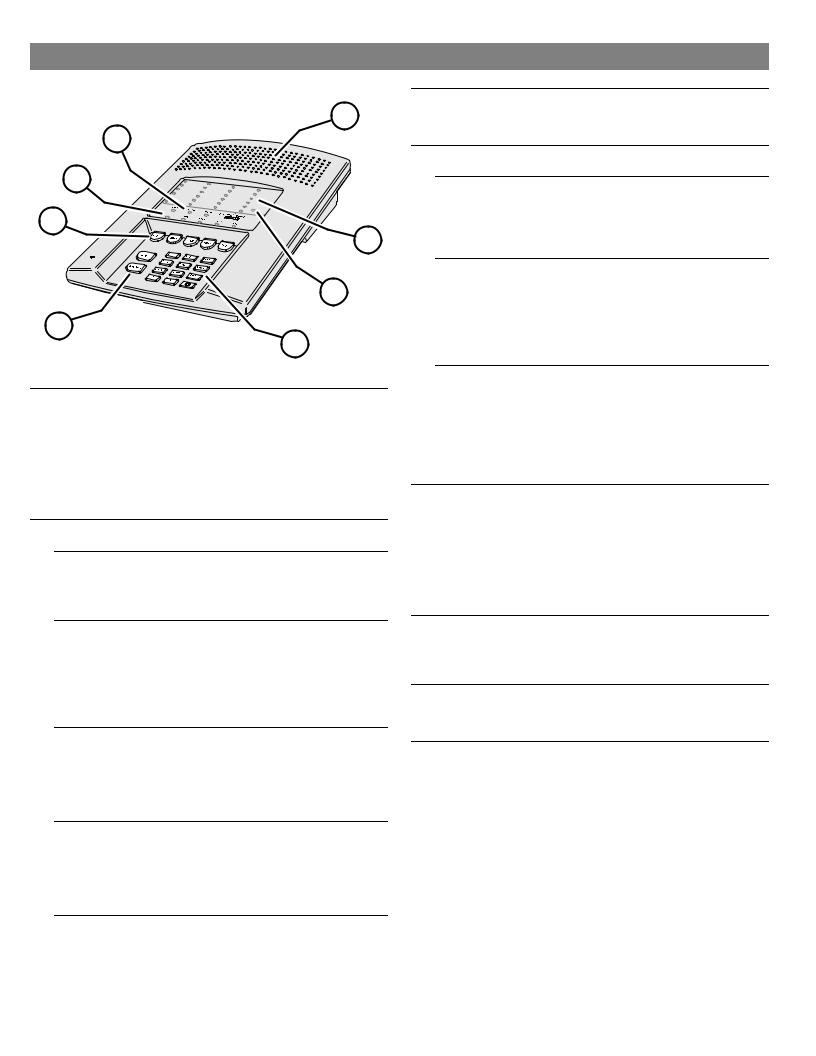
4. CONSOLE FEATURES
5
4
3
2
6
7
1
8
124-HOUR BUTTONS
Pressing the [FIRE] button for two seconds sounds the fire siren and sends a “fire” message to a central monitoring station through the digital communicator (if the system is monitored).
Pressing the [EMERGENCY] button for two seconds sounds the emergency siren and sends an “emergency” message to a central monitoring station through the digital communicator (if the system is monitored).
Both work even when system is disarmed.
IMPORTANT: For personal emergency use only.
2MODE BUTTONS
Used to control the Console.
OFF
Off Mode disarms the system.
Switching to Off Mode stops the alarm siren.
Multiple beeps sound and status lights flash if an alarm has occurred.
Multiple beeps mean caution. AN INTRUDER MAY STILL BE PRESENT.
CHIME
Chime Mode disarms the system.
Switching to Chime Mode stops the alarm siren.
Multiple beeps sound and status lights flash if an alarm has occurred.
Multiple beeps mean caution. AN INTRUDER MAY STILL BE PRESENT.
Chime Mode is for monitoring doors and windows.
Use this mode as an “automatic door chime” when at home.
Opening any protected door or window causes Console to “ding-dong”.
HOME
Home Mode arms the perimeter sensors, but not the interior sensors.
Use this mode when anyone is staying behind.
Interior motion detectors and interior door sensors are not armed.
Home secure mode makes all delayed perimeter sensors instant.
Secure exit mode starts an exit delay while remaining in Home Mode.
Re-entering during the exit delay restarts the exit delay (one time only).
AWAY
Away Mode arms the entire system.
Use this mode when leaving home.
Door sensors set for “delayed” will have a delay that allows you to leave and enter the premises without sounding the alarm.
Re-entering during the exit delay restarts the exit delay (one time only).
Entry Delay beeps warn you to disarm the system before the siren starts.
TEST
Test Mode is for testing the system sensors.
All sensor status lights blink when the Test Mode is entered.
Each sensor status light will stop blinking when its sensor is tested.
Hold the [TEST] button down to test all of the Console’s indicator lights.
3MODE INDICATORS
Specific indicator will light showing the mode the Console is in.
HOME indicator will blink during secure exit and home instant modes.
AWAY indicator will blink during the exit delay in the Away Mode.
4CONSOLE STATUS INDICATORS
Show the current status of the Console.
POWER LIGHT
Glows when AC power is on.
Dims when AC power is off and backup battery is installed.
Blinks when the backup battery is low, recharging or missing.
Off when AC power is off and no backup battery is installed (system disabled).
BATTERIES LIGHT
Blinks when one or more sensors has a low battery.
Press [ ] key for two seconds to view sensor status. Sensor status indicator for any sensor with a low battery will light along with the BATTERIES indicator.
Switch to Test Mode after replacing the sensor battery and completely test the system (see Test Mode). Switching to Test Mode clears the low battery indication.
TROUBLE LIGHT
Blinks when one or more sensors have not reported status during the eight hour status time window.
Press [ ] key for two seconds to view sensor status. Sensor status indicator for any sensor that has not reported in will light along with the TROUBLE indicator.
Switch to Test Mode after servicing the sensor and completely test the system (see Test Mode). Switching to Test Mode clears the trouble indication.
5SIREN SPEAKER
Makes unique sounds for burglary, fire and emergencies.
Alarm sirens stop automatically after five minutes.
Sounds advisory tones to confirm keystrokes from the Console.
Sounds mode selections tones.
Sounds alarm memory tones.
Beeps when Automation Output is activated.
Speaks the system status information when optional VB-2 or VB-3 digital voice synthesis module is installed.
Terminals available for an external siren.
6STATUS INDICATORS
Indicates the status of each of the system’s sensors.
Lights show which doors and windows are open.
Lights flash to display sensors that have caused an alarm.
Stick-on labels are provided to identify the custom sensor locations.
7CASE ACCESS SCREW (HIDDEN)
Remove clear display window and sensor identification card to gain access to the screw.
Remove case access screw to unlock case. Case hinges open to the left.
8KEYPAD
Backlit keys for easy viewing in low light conditions.
For entering the user’s user code (numerically or alphabetically).
Used when programming system options.
Press [(A)] key to activate Automation Output.
Press the [ ] key to clear keypad if the wrong key is pressed.
Press and hold the [ ] key for one second to view sensor battery and supervisory status (see BATTERIES and TROUBLE indicator description).
6

13 |
14 |
15 |
16 |
|
|
||
|
|
|
11 12
10
17
22
21
20
10AUXILIARY FUSE
Type 2AG, 1-amp fuse.
Protects the external relay output when used with wet contacts (12 VDC switched out).
Fuse will blow when load exceeds 1 amp.
WARNING: For continued protection against the risk of fire, replace only with the same type and rating of fuse.
11MAIN TERMINAL BLOCK
Terminals for connection to the plug-in AC transformer.
Terminals for connection to an external speaker.
Automation Output to connect to an automation controller.
External relay output for “wet” contacts (switched 12 volts) or “dry” contacts (normally open 1 amp @ 24 volts maximum).
12BATTERY FUSE
Type 2AG, 3-amp fuse for the backup battery.
If the POWER light is flashing and the optional backup battery is installed and charged, check this fuse.
WARNING: For continued protection against the risk of fire, replace only with the same type and rating of fuse.
13TELEPHONE TERMINAL BLOCK
Provides telephone connections for the digital communicator.
Provides telephone connection for voice prompted telephone remote control (optional VB-2 digital voice synthesis module required).
Provides seized ring and tip connections for local telephone instruments. Communicator will disconnect local telephones while on-line.
14INTERNAL SPEAKER CONNECTOR
Connects the internal speaker to the Console circuit board.
2-pin connector, non-polarized.
15ANTENNA TERMINALS
Antenna and ground terminals for receiving signals from the system’s sensors.
Pre-wired to the Console’s internal wire dipole antenna.
Alternately connects to the Model LA-P local whip and remote antenna kit.
16OPTIONAL BACKUP BATTERY
Space for 12-volt, 1.2 amp/hour backup battery. (Highly recommended.)
Backup battery is automatically charged and monitored by the Console.
Backup battery can power the Console for up to 6 hours.
18
19
17WIRING ACCESS HOLE
Provides access to recessed wiring trough in base of Console.
Route cables for power, telephone, external speaker, etc. through this hole.
Loop for zip-tie strain relief provided next to hole.
18WALL-MOUNT SLOTS
Used when mounting Console recessed in the wall.
Two mounting brackets (supplied) slide through slots and are retained by screws, clamping the unit to the wall.
19RADIO TEST POINTS
Used to monitor the Console’s radio receiver during troubleshooting.
Provides connection for an audio amplifier to listen to the receiver’s output.
Helpful to determine sources of radio interference.
20MICROPHONE (WITH MODEL VB-2 INSTALLED ONLY)
High sensitivity microphone.
Detects room audio when communicator is reporting to the Central Station in 2-way audio mode (Model VB-2 digital voice synthesis module must be installed).
21ANNUNCIATOR VOLUME CONTROL
Varies the volume of the advisory tones that come from the speaker.
Does not affect internal or external sirens (they are always full volume).
22DIGITAL VOICE SYNTHESIS MODULE (OPTIONAL)
Two voice synthesis modules are available, the Model VB-2 and VB-3.
Both modules allow remote command of the Console using a standard pushbutton telephone, on or off site.
Both modules provide optional human voice prompts from the Console’s speaker.
The Model VB-2 gives the Console’s digital communicator listen-only, manual 2-way and full duplex 2-way audio capability with the Central Station.
7
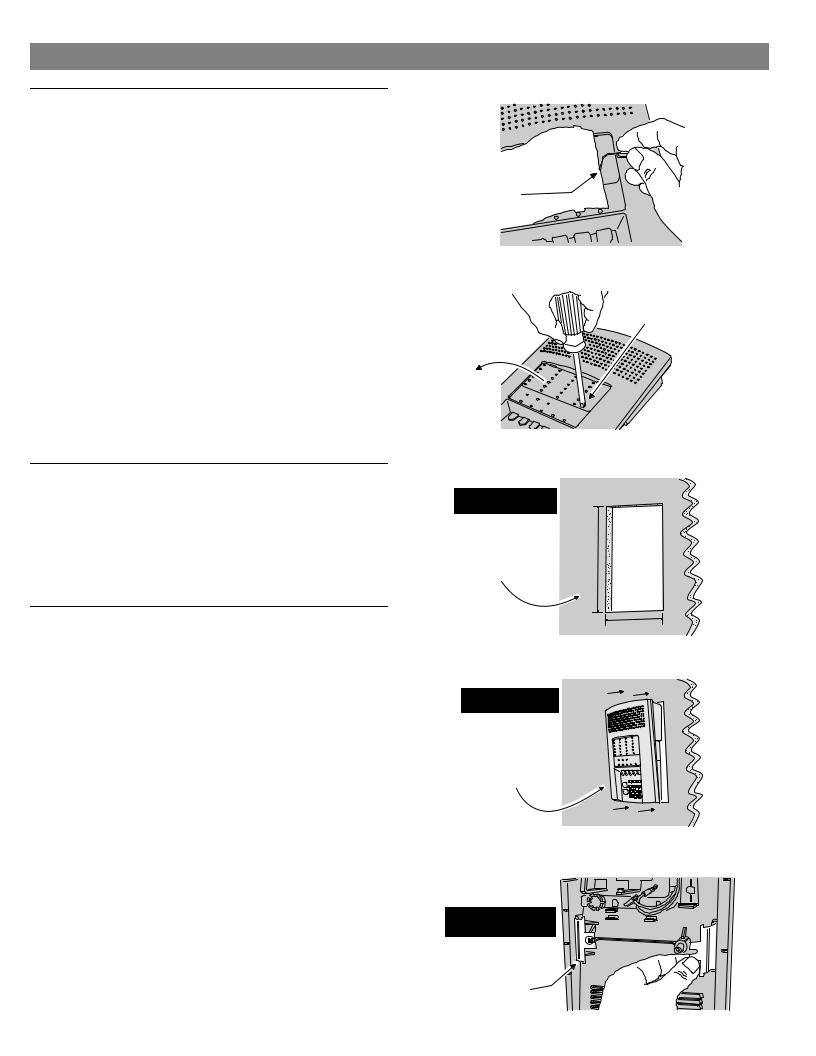
5. CONSOLE INSTALLATION
CONSOLE LOCATION
NOTE: Sensor signals must be able to reach the Console.
Try to centrally locate the Console.
Keep Console away from large metal appliances.
Maximum recommended sensor range is 400 feet (system tested at 1000 feet).
NOTE: If you don’t use the Wireless Keypad, the Console should be easily accessible to the usual entrance.
When the Console is set in the Away Mode, the user has 30 seconds to switch to Off Mode before the burglary siren sounds.
NOTE: Make sure the Console is in a place where the alarm can be heard during the night hours.
Optional remote external sirens (up to 150 feet from the Console) can be used to make alarms louder and remote their location.

 Locate the Console near an AC power outlet that’s not controlled by a light switch.
Locate the Console near an AC power outlet that’s not controlled by a light switch.

 Locate the Console near a telephone outlet (if using the digital communicator).
Locate the Console near a telephone outlet (if using the digital communicator).
CASE LOCKING SCREW
To access the Console’s internal components or to prepare the Console for wall mounting, the case locking screw needs removing.

 Use a paper clip to remove the clear plastic display window.
Use a paper clip to remove the clear plastic display window.
 Remove the sensor number nameplate.
Remove the sensor number nameplate. 
 Remove the case locking screw.
Remove the case locking screw.
WALL MOUNTING
If desired, the Console can be surface mounted or recessed into the wall.
Surface Mounting

 For surface mounting, use the Console’s case bottom as a template and mark the locations for the four mounting screws.
For surface mounting, use the Console’s case bottom as a template and mark the locations for the four mounting screws.

 Use four screws and appropriate screw anchors to temporarily mount the unit to the wall (the unit will need to be removed to complete the recessed wiring hook up).
Use four screws and appropriate screw anchors to temporarily mount the unit to the wall (the unit will need to be removed to complete the recessed wiring hook up).
Recessed Mounting

 For recessed wall mounting, cut a 10" by 6-3/4" hole, centered between studs, in the mounting wall at a convenient height.
For recessed wall mounting, cut a 10" by 6-3/4" hole, centered between studs, in the mounting wall at a convenient height.

 Slide the unit into the mounting hole and temporarily secure it with the two retaining clamps and screws provided (the unit will need to be removed to complete the recessed wiring hook up).
Slide the unit into the mounting hole and temporarily secure it with the two retaining clamps and screws provided (the unit will need to be removed to complete the recessed wiring hook up).
USE A PAPER
CLIP TO REMOVE
THE CLEAR
DISPLAY WINDOW
|
REMOVE CASE |
|
LOCKING SCREW TO |
REMOVE SENSOR |
ACCESS INTERNAL |
COMPONENTS |
|
NAMEPLATE TO |
|
ACCESS CASE |
|
SCREW |
|
FOR RECESSED
WALL MOUNTING ONLY
CUT A 10" x 6 3/4"
HOLE CENTERED
BETWEEN STUDS
IN MOUNTING WALL 10"
AT A CONVENIENT
HEIGHT
6 3/4"
FOR RECESSED
WALL MOUNTING ONLY
SLIDE CONSOLE
INTO WALL OPENING
FOR RECESSED
WALL MOUNTING ONLY
SECURE CONSOLE
TO WALL USING THE
TWO CLAMPS AND
SCREWS PROVIDED
8
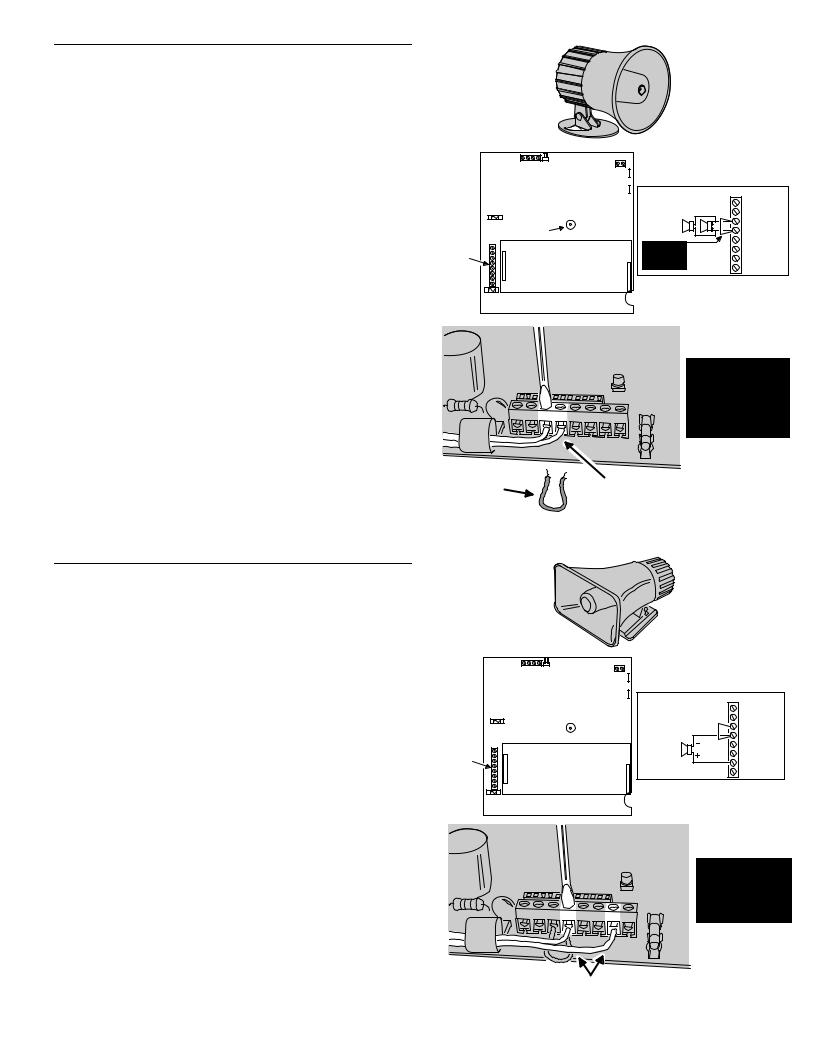
EXTERNAL CONSOLE SPEAKER CONNECTION (OPTIONAL)
An external console speaker sounds system tones and alerts occupants with a loud siren during alarm.
With the VB-2 module installed, the Central Station can talk to the occupants through the external console speaker.
Use an 8-ohm, 10 watt minimum rated speaker. Do not use a horn/siren with a built-in siren driver.
Up to two 8-ohm speakers can be used with each Console.
Up to 150 feet of 22 AWG wire can be used with each speaker.

 Mount the external speaker.
Mount the external speaker.

 Route the speaker wires from the external speaker to the Console.
Route the speaker wires from the external speaker to the Console.

 Open the Console top cover and locate the main terminal block.
Open the Console top cover and locate the main terminal block.

 Route the speaker wires up through the wiring access hole.
Route the speaker wires up through the wiring access hole.

 Remove the wire jumper from the EXT. SPKR & (-) terminals.
Remove the wire jumper from the EXT. SPKR & (-) terminals.

 Connect the speaker wires to the EXT. SPKR & (-) terminals.
Connect the speaker wires to the EXT. SPKR & (-) terminals.
NOTE: If connecting two external speakers, connect the second speaker in parallel, to the same EXT. SPKR & (-) terminals as the first speaker.

 The system tone volume can be adjusted with the annunciator volume control.
The system tone volume can be adjusted with the annunciator volume control.
EXTERNAL ALARM SIREN CONNECTION (OPTIONAL)
An external siren alerts occupants and neighbors with a loud siren during alarm.
Use a 12 volt, 1 amp maximum rated weather-resistant horn speaker with a built-in siren driver. Do not use a plain speaker.
NOTE: Connection of an electromechanical bell or motor bell is not recommended because of the radio interference generated when the bell is running.

 Mount the external siren.
Mount the external siren.

 Route the wires from the external siren to the Console.
Route the wires from the external siren to the Console.

 Open the Console top cover and locate the main terminal strip.
Open the Console top cover and locate the main terminal strip.

 Route the siren wires up through the wiring access hole.
Route the siren wires up through the wiring access hole.

 Connect the siren wires to the RELAY N.O. & (-) terminals.
Connect the siren wires to the RELAY N.O. & (-) terminals.
NOTE: By removing the Console’s auxiliary fuse, the relay contacts will become isolated. Use the RELAY N.O. & RELAY DRY terminals to switch an externally powered load.
EXTERNAL
CONSOLE
LINEAR SECURITY CONSOLE MODEL DVS-2400
|
|
MAIN TERMINAL BLOCK |
|
|
|
|
AC |
|
|
|
AC |
|
ANNUNCIATOR |
EXT. SPKR(S) |
EXT. SPKR |
|
VOLUME |
8 OHM/10 WATT |
(-) |
MAIN |
CONTROL |
2 SPKRS MAX. |
H/A - |
|
NOTE: REMOVE |
||
TERMINAL |
|
H/A + |
|
BLOCK |
OPTIONAL |
JUMPER FOR |
RELAY N.O. |
|
VOICE MODULE |
EXT. SPEAKERS |
RELAY DRY |
|
MODEL: VB-2 OR VB-3 |
|
|
EXTERNAL
CONSOLE
SPEAKER
8 OHM, 10 WATT
MINIMUM
REMOVE
JUMPER
CONNECT SPEAKER LEADS
TO EXT. SPKR & (-) TERMINALS
EXTERNAL
ALARM
LINEAR SECURITY CONSOLE MODEL DVS-2400
|
|
MAIN TERMINAL BLOCK |
|
|
|
|
AC |
|
|
|
AC |
|
|
EXTERNAL SIREN |
EXT. SPKR |
|
|
(-) |
|
|
|
12 VDC 1 AMP |
|
MAIN |
|
H/A - |
|
|
MAXIMUM |
||
TERMINAL |
|
|
H/A + |
BLOCK |
OPTIONAL |
|
RELAY N.O. |
|
VOICE MODULE |
|
RELAY DRY |
|
MODEL: VB-2 OR VB-3 |
|
|
EXTERNAL
ALARM RELAY 12 VDC 1 AMP MAXIMUM
CONNECT SIREN LEADS TO (-) & RELAY N.O. TERMINALS
9
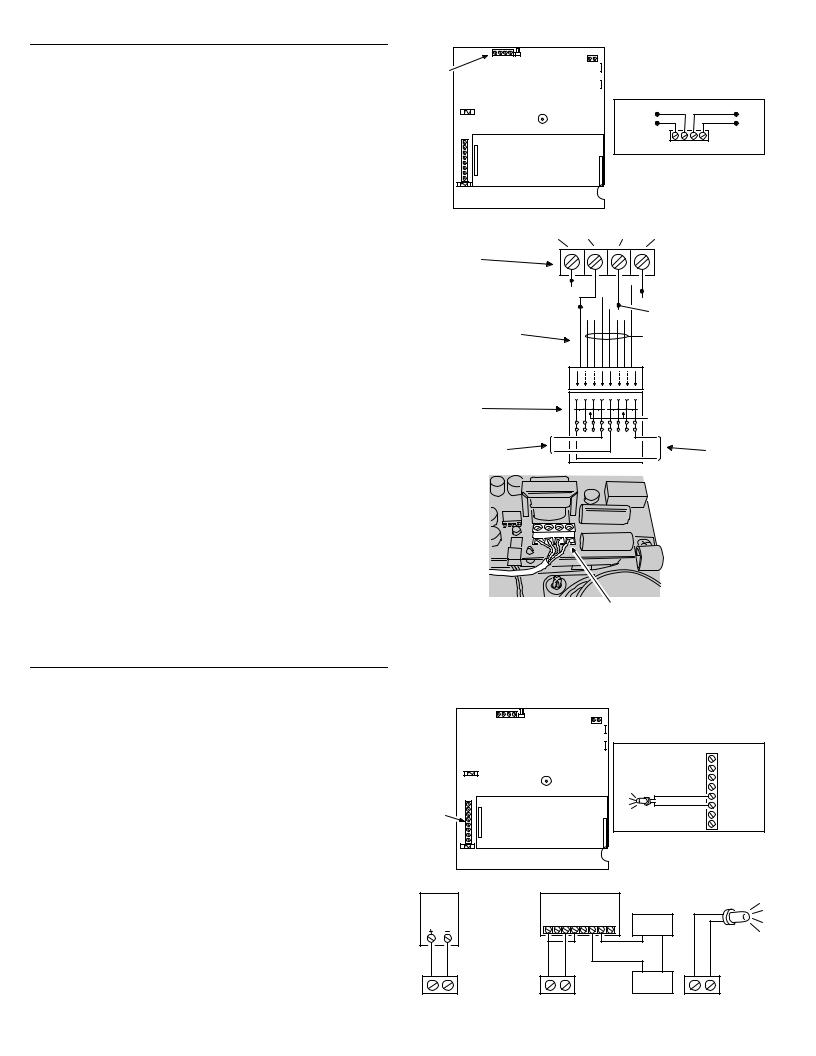
TELEPHONE LINE CONNECTION (OPTIONAL)
Connect the Console to the telephone line if the system is monitored, requires 2-way audio, or requires telephone remote command.
Telephone ring & tip terminals are for connection to the incoming telephone line.
Seized telephone ring & tip are for connection to local telephone sets. When the communicator activates, all the local telephone sets will be disconnected to prevent an off-hook telephone on the premises from blocking the communicator call.

 Install a USOC RJ31-X or RJ38-X jack to the telephone system near the Console.
Install a USOC RJ31-X or RJ38-X jack to the telephone system near the Console.

 Route an appropriate modular telephone line cord from the jack to the Console.
Route an appropriate modular telephone line cord from the jack to the Console.

 Route the line cord through the Console’s wiring access hole.
Route the line cord through the Console’s wiring access hole.

 Connect the incoming telephone line wires to the Console’s telephone terminal block TIP and RING terminals.
Connect the incoming telephone line wires to the Console’s telephone terminal block TIP and RING terminals.
Connect the local telephone set wires to the Console’s telephone terminal block SEIZED TIP and SEIZED RING terminals.
When directly connecting (without a telephone line) to the DVS-2400 with the RA-2400 remote access software (Version 1.3 or later), disconnect the incoming telephone line and connect the modem to the panel’s TIP and RING terminals (with the modem’s red & green phone line wires). Press the [EMERGENCY] key while in Test Mode to cause the panel to connect to the modem.
TELEPHONE
TERMINAL LINEAR SECURITY CONSOLE MODEL DVS-2400
BLOCK
|
|
|
TELEPHONE TERMINAL BLOCK |
||
|
|
SEIZED RING |
|
TIP |
|
|
|
SEIZED TIP |
|
RING |
|
|
|
TO LOCAL |
R T R1 T1 |
TO PHONE |
|
OPTIONAL |
|
PHONES |
LINE |
||
|
|
|
|
|
|
VOICE MODULE |
|
|
|
|
|
MODEL: VB-2 OR VB-3 |
|
|
|
|
|
SEIZED |
SEIZED |
LINE |
LINE |
|
|
TIP (T1) |
RING (R1) |
TIP (T) |
RING (R) |
|
|
DVS-2400 TELEPHONE
TERMINAL
BLOCK
BROWN 




 RED
RED
GRAY 
 GREEN
GREEN
8-PIN |
BLUE, ORANGE |
|
MODULAR |
||
PHONE CORD |
BLACK, AND |
|
YELLOW NOT |
||
|
||
|
USED |
8-POSITION |
|
R1 |
|
|
R |
T |
|
|
T1 |
SHORTING BAR |
|
USOC RJ31-X |
|
|
|
|
|
|
|
|
|
SHORT REMOVED |
|
(OR RJ38-X) |
|
|
|
|
|
|
|
|
|
ON PLUG |
|
JACK |
|
1 |
2 |
3 |
4 |
5 |
6 |
7 |
8 |
INSERTION |
|
|
R |
|
|
|
|
|
|
|
|
T1 |
TO LOCAL |
TO TELEPHONE |
T |
|
|
|
|
|
|
|
|
|
|
|
|
|
|
|
|
|
|
|
TELEPHONE |
||
|
|
|
|
|
|
|
|
|
R1 |
||
NETWORK |
|
|
|
|
|
|
|
|
|
|
SETS |
CONNECT TELEPHONE LINE
TO THE TELEPHONE
TERMINAL BLOCK
AUTOMATION OUTPUT CONNECTION (OPTIONAL)
The Console provides a Automation Output to control lights, devices and appliances.
Automation Output can connect to most popular home automation devices and other simple electronic devices (see Figure).

 Press [(A)] to turn the Automation Output on, press [(A)] again to turn it off.
Press [(A)] to turn the Automation Output on, press [(A)] again to turn it off.
Programmable Options
There are many programmable options for the Automation Output.
The Automation Output can be programmed for a variety of useful functions, such as: flashing during alarm, flashing after an alarm, on while armed, or, on during exit/entry delays.
See the “Advanced Programming” section of this manual for details on changing the function of the Automation Output.
10
LINEAR SECURITY CONSOLE MODEL DVS-2400
MAIN
TERMINAL
BLOCK OPTIONAL VOICE MODULE
MODEL: VB-2 OR VB-3
MINUS H/A TERMINAL WILL SWITCH TO GROUND WHEN AUTOMATION OUTPUT IS ACTIVATED
MAIN TERMINAL BLOCK
|
AC |
LIGHT EMITTING |
AC |
EXT. SPKR |
|
DIODE (L.E.D.) |
(-) |
|
H/A - |
|
H/A + |
|
RELAY N.O. |
|
RELAY DRY |
POSITIVE H/A TERMINAL PROVIDES +12 VOLTS DC AND IS CURRENT LIMITED AT 30 MILLIAMPS MAXIMUM
|
EXAMPLE AUTOMATION OUTPUT HOOK-UPS |
|
|
|
X-10 |
LINEAR RB-90 |
|
X-10 |
BURGLAR ALARM |
|
|
RELAY MODULE |
|
||
INTERFACE |
|
||
|
YOUR |
|
|
|
(CAN CONTROL |
LOAD |
LIGHT |
|
HOUSE LIGHTS |
|
|
|
|
EMITTING |
|
|
THROUGH X-10 |
|
|
|
|
DIODE |
|
|
SYSTEM) |
|
|
|
|
(L.E.D.) |
|
|
|
|
|
POWER
SOURCE
H/A + H/A - |
H/A + H/A - |
H/A + H/A - |
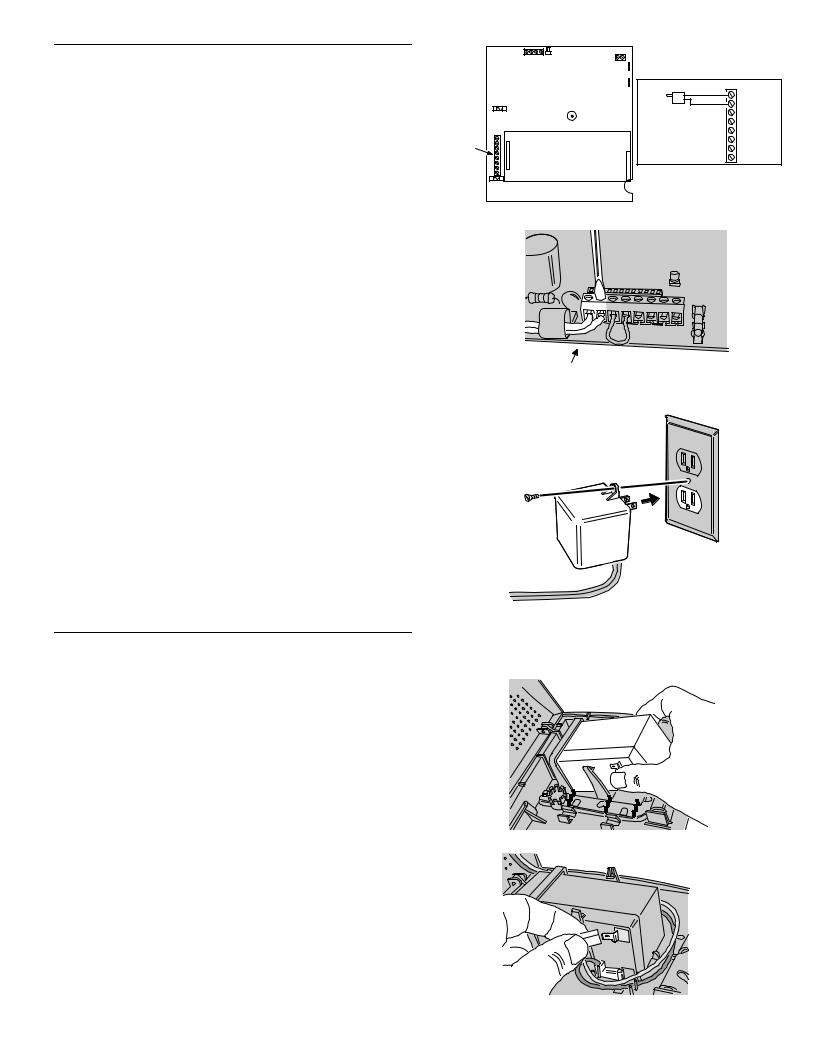
CONSOLE POWER CONNECTION
The Console is powered by a low voltage plug-in transformer.
Use up to 25 feet of 20 AWG or larger two-conductor wire to connect the transformer to the Console.

 Route the power wires from the plug-in transformer to the Console.
Route the power wires from the plug-in transformer to the Console.

 Connect the wires to the transformer terminals
Connect the wires to the transformer terminals
(do not plug the transformer in until the wiring is complete).

 Route the power wires through the Console’s wiring access hole.
Route the power wires through the Console’s wiring access hole.

 Connect the power wires from the transformer to the Console’s main terminal block AC & AC terminals.
Connect the power wires from the transformer to the Console’s main terminal block AC & AC terminals.

 Secure all of the wires entering the Console with a zip-tie to the Console’s strain relief loop.
Secure all of the wires entering the Console with a zip-tie to the Console’s strain relief loop.
 Plug transformer into an unswitched AC outlet.
Plug transformer into an unswitched AC outlet. 
 Secure transformer with screw to prevent un-plugging.
Secure transformer with screw to prevent un-plugging.
LINEAR SECURITY CONSOLE MODEL DVS-2400
|
MAIN TERMINAL BLOCK |
||
|
|
AC |
|
|
|
AC |
|
|
|
EXT. SPKR |
|
|
PLUG-IN TRANSFORMER |
(-) |
|
MAIN |
16 VAC, 28 VA |
H/A - |
|
OUTPUT RATING |
|||
TERMINAL |
H/A + |
||
OPTIONAL |
|||
BLOCK |
RELAY N.O. |
||
VOICE MODULE |
RELAY DRY |
||
|
|||
|
MODEL: VB-2 OR VB-3 |
|
|
CONNECT TRANSFORMER LEADS
TO AC POWER TERMINALS
PLUG TRANSFORMER
INTO AC POWER OUTLET
THAT IS NOT CONTROLED
BY A LIGHT SWITCH
SCREW
AC POWER
OUTLET
TRANSFORMER
BACKUP BATTERY INSTALLATION (OPTIONAL)
A 12 volt backup battery may be installed and is highly recommended.
The backup battery will power the Console for up to 6 hours during AC power loss.
The backup battery is automatically charged by the Console when AC power is present.
A low backup battery will cause the Console POWER indicator to flash as it is being charged.

 To install the battery, slide the battery between the retaining clamps and under the battery holder.
To install the battery, slide the battery between the retaining clamps and under the battery holder.

 Position the battery until the clamps snap in place. The battery terminals should be facing the center of the Console case bottom.
Position the battery until the clamps snap in place. The battery terminals should be facing the center of the Console case bottom.

 Connect the black battery lead to the black battery terminal.
Connect the black battery lead to the black battery terminal.

 Connect the red battery lead to the red battery terminal.
Connect the red battery lead to the red battery terminal.
WARNING: DO NOT REVERSE THE BATTERY LEADS! THE BATTERY FUSE WILL BLOW.
SLIDE BACKUP BATTERY
INTO BATTERY CLAMPS
CONNECT RED BATTERY LEAD TO RED TERMINAL
CONNECT BLACK BATTERY LEAD TO BLACK TERMINAL
CAUTION: DO NOT REVERSE BATTERY LEADS
BATTERY FUSE WILL BLOW
11
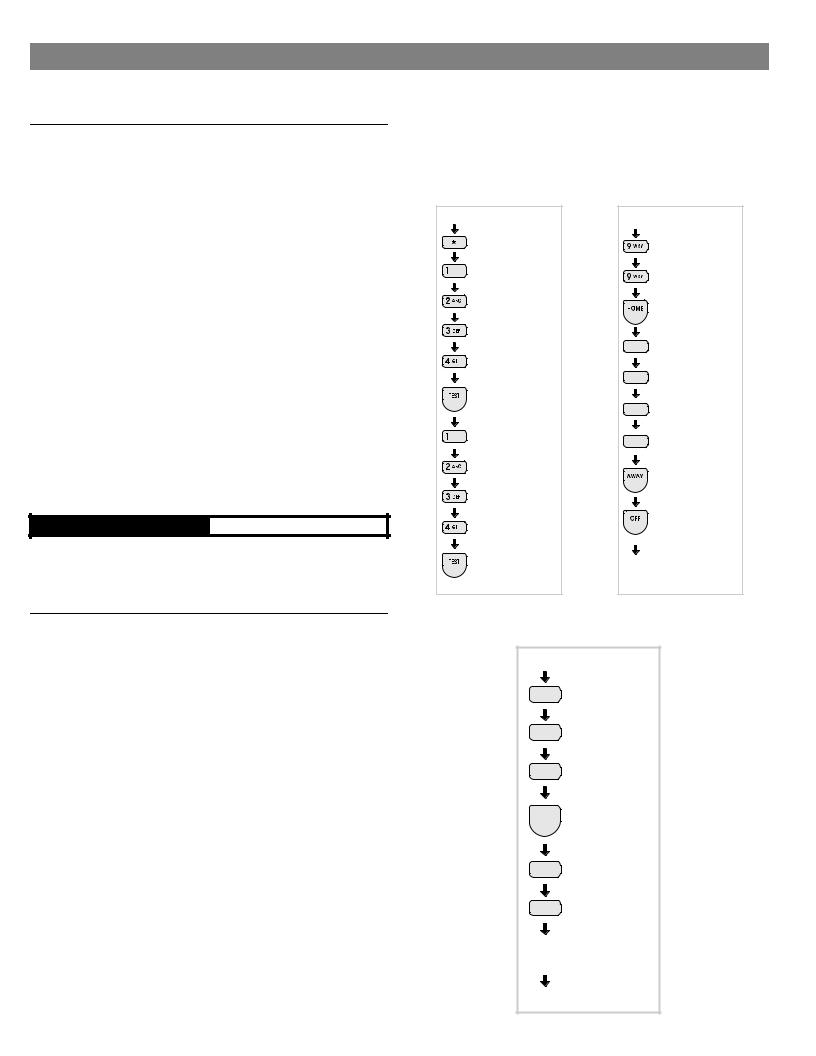
6. BASIC CONSOLE PROGRAMMING
In a new installation, when power is first applied the Console’s master user code is “1234”.
CREATE THE MASTER USER CODE
NOTE: Local programming must be entered on the Console’s keypad, not on a wireless remote keypad.

 Press [ ] (clears keypad if any other keys have been pressed).
Press [ ] (clears keypad if any other keys have been pressed).

 Place the Console in Test Mode (enter 1234 and press [TEST].
Place the Console in Test Mode (enter 1234 and press [TEST].
A “gong” and four “beeps” will sound.

 Enter the Setup Mode from Test Mode, enter 1234 then press [TEST] again.
Enter the Setup Mode from Test Mode, enter 1234 then press [TEST] again.
A “gong” and five “beeps” will sound. You are now in Setup Mode.

 Enter 99 then press [HOME].
Enter 99 then press [HOME].

 Enter any combination of 1-5 digits for the master user code, then press [AWAY].
Enter any combination of 1-5 digits for the master user code, then press [AWAY].
NOTE: For maximum security, a three to five digit code is recommended.

 Press and hold the [OFF] key for 3 seconds to exit program mode.
Press and hold the [OFF] key for 3 seconds to exit program mode.

 Test the new master user code by entering it then pressing [TEST].
Test the new master user code by entering it then pressing [TEST].

 Log the master user code in the box below.
Log the master user code in the box below.
MASTER USER CODE
NOTE: The master user code can be used to enter Setup Mode. The restricted user codes cannot. To create restricted user codes, see the “Advanced Programming” section of this manual.
PROGRAM THE SENSORS INTO THE CONSOLE’S MEMORY
Each wireless sensor that is going to be used with the Console must be programmed into the Console’s memory.

 Start with the Console in Test Mode (enter any user code and press [TEST]).
Start with the Console in Test Mode (enter any user code and press [TEST]).

 Enter the Setup Mode from Test Mode, enter the master user code then press [TEST] again.
Enter the Setup Mode from Test Mode, enter the master user code then press [TEST] again.
A “gong” and five “beeps” will sound. You are now in Setup Mode.
The sensor status indicators will light for any sensors programmed into the Console.

 Enter an unused sensor number from 01-24 (you must enter two digits, example: 5 = 05)
Enter an unused sensor number from 01-24 (you must enter two digits, example: 5 = 05)
The sensor indicator light will flash for the sensor number selected.

 Activate the sensor by sending a test or alarm signal (be sure the sensor’s battery is connected or that its battery protection strip is removed).
Activate the sensor by sending a test or alarm signal (be sure the sensor’s battery is connected or that its battery protection strip is removed).
A single “bing” tone will sound and the sensor status indicator for that sensor will stay lit.

 Enter another sensor number or exit Setup Mode by holding the [OFF] key for three seconds.
Enter another sensor number or exit Setup Mode by holding the [OFF] key for three seconds.
ENTERING |
SETTING A |
|
SETUP |
NEW MASTER |
|
MODE |
USER CODE |
|
START IN OFF |
START IN SETUP |
|
CLEARS |
|
|
KEYPAD |
PROGRAMMING |
|
|
||
|
STEP #99 |
|
DEFAULT |
|
|
MASTER |
PROGRAM |
|
USER |
|
|
CODE |
|
|
|
NEW |
|
1 GONG & |
MASTER |
|
4 BEEPS |
USER |
|
(TEST MODE) |
CODE |
|
DEFAULT |
STORE |
|
MASTER |
||
CODE |
||
USER |
||
|
||
CODE |
HOLD FOR |
|
|
3 SECONDS |
|
|
TO EXIT |
|
1 GONG & |
SETUP |
|
|
||
5 BEEPS |
DONE |
|
(SETUP MODE) |
||
|
START IN TEST
MASTER
USER
CODE
1 GONG &
TEST
5 BEEPS
NEW
SENSOR
NUMBER
ACTIVATE
SENSOR
DONE
12
